Nursing Theories and Models: A Critical Discussion on the Roy Adaptation Model (RAM) and its Application in Managing Basic Needs of a Chronic Kidney Disease Patient
VerifiedAdded on 2022/12/26
|12
|3566
|51
AI Summary
This report critically discusses the Roy Adaptation Model (RAM) in nursing practice, focusing on its significance and application in managing the basic needs of a Chronic Kidney Disease patient. The RAM aims to promote patient adaptation and enhance compliance, providing holistic care based on scientific knowledge. The report explores the components, assumptions, and adaptive modes of the RAM, highlighting its effectiveness in improving the physiological and psychological adaptation of patients with chronic kidney disease.
Contribute Materials
Your contribution can guide someone’s learning journey. Share your
documents today.
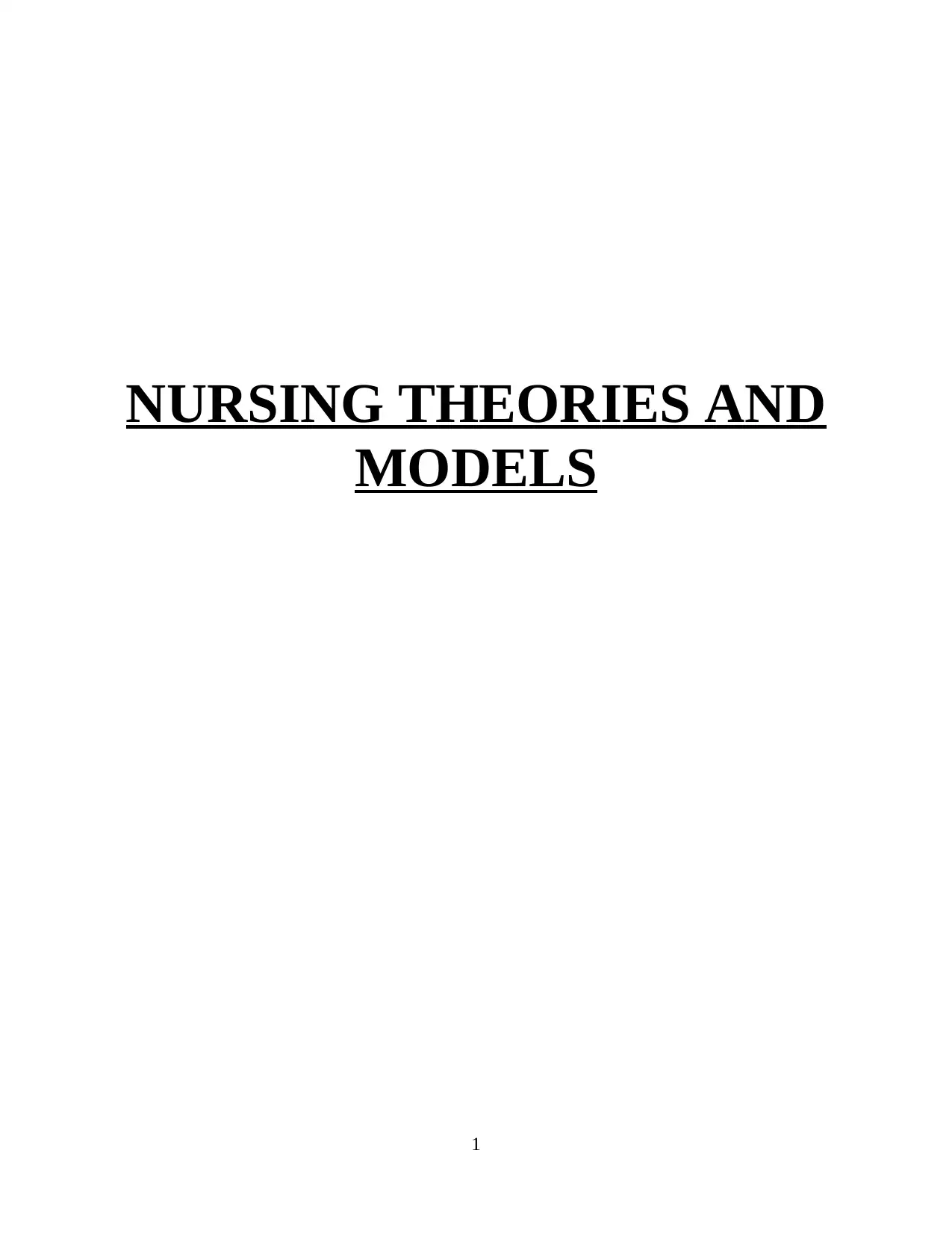
NURSING THEORIES AND
MODELS
1
MODELS
1
Secure Best Marks with AI Grader
Need help grading? Try our AI Grader for instant feedback on your assignments.

2
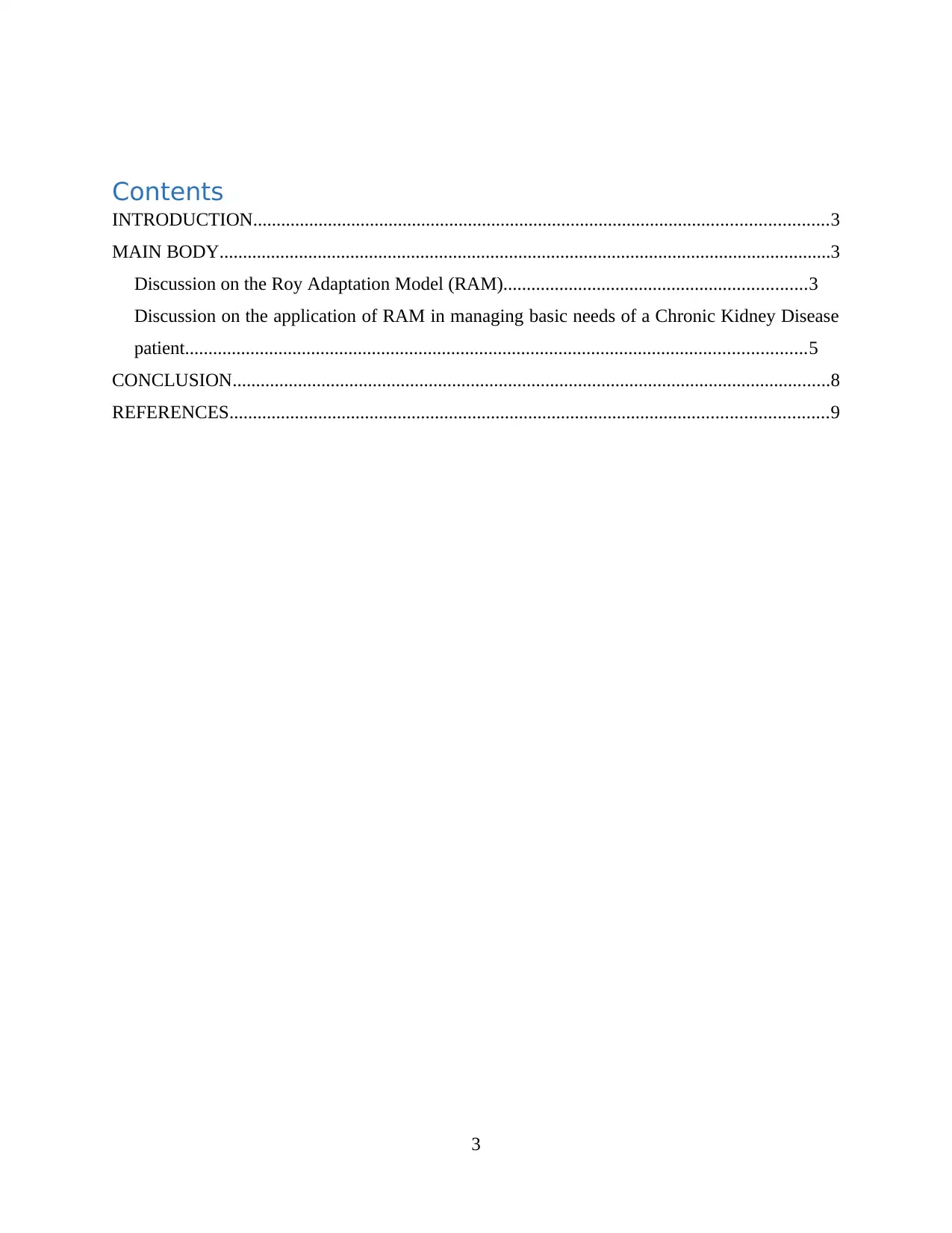
Contents
INTRODUCTION...........................................................................................................................3
MAIN BODY...................................................................................................................................3
Discussion on the Roy Adaptation Model (RAM).................................................................3
Discussion on the application of RAM in managing basic needs of a Chronic Kidney Disease
patient.....................................................................................................................................5
CONCLUSION................................................................................................................................8
REFERENCES................................................................................................................................9
3
INTRODUCTION...........................................................................................................................3
MAIN BODY...................................................................................................................................3
Discussion on the Roy Adaptation Model (RAM).................................................................3
Discussion on the application of RAM in managing basic needs of a Chronic Kidney Disease
patient.....................................................................................................................................5
CONCLUSION................................................................................................................................8
REFERENCES................................................................................................................................9
3
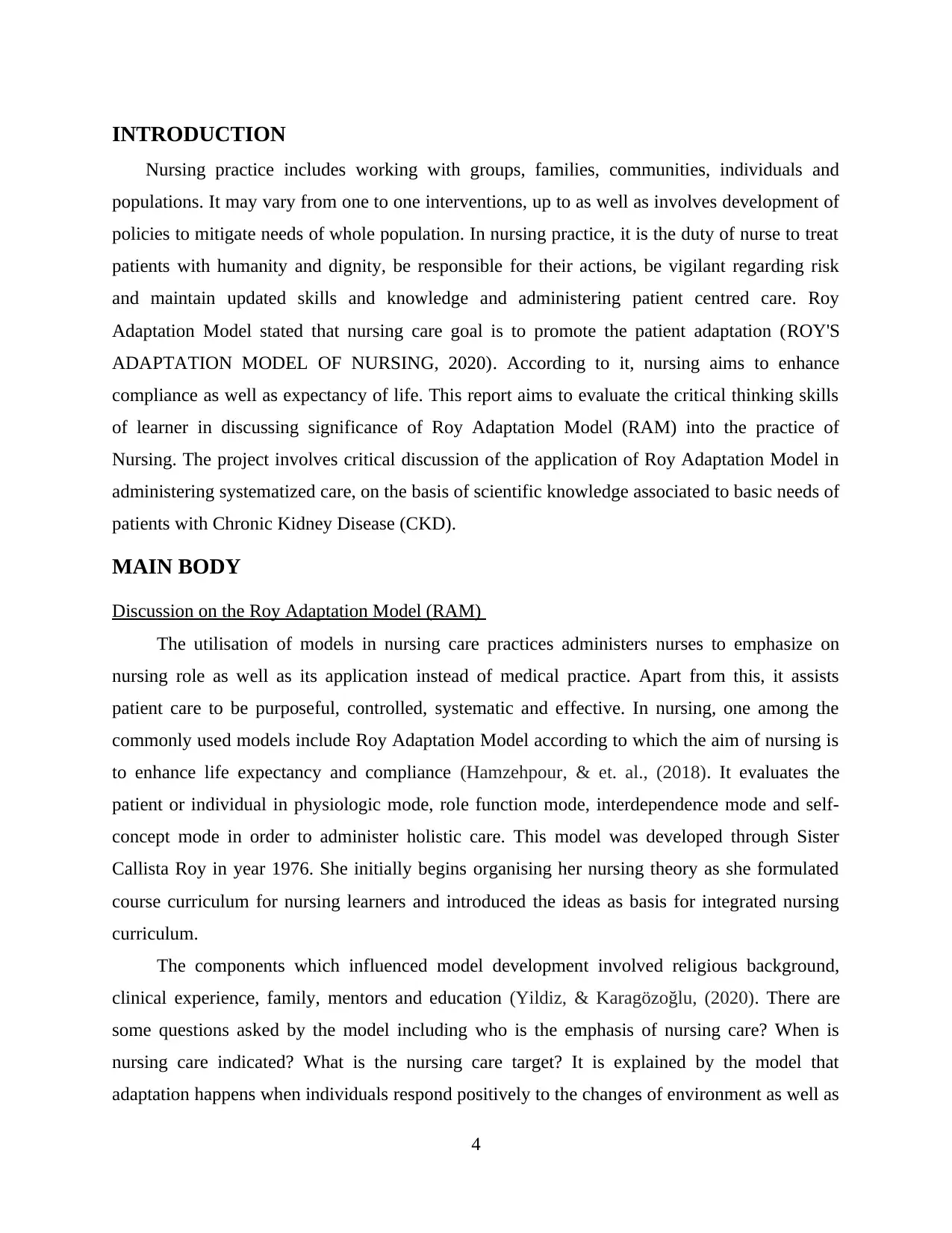
INTRODUCTION
Nursing practice includes working with groups, families, communities, individuals and
populations. It may vary from one to one interventions, up to as well as involves development of
policies to mitigate needs of whole population. In nursing practice, it is the duty of nurse to treat
patients with humanity and dignity, be responsible for their actions, be vigilant regarding risk
and maintain updated skills and knowledge and administering patient centred care. Roy
Adaptation Model stated that nursing care goal is to promote the patient adaptation (ROY'S
ADAPTATION MODEL OF NURSING, 2020). According to it, nursing aims to enhance
compliance as well as expectancy of life. This report aims to evaluate the critical thinking skills
of learner in discussing significance of Roy Adaptation Model (RAM) into the practice of
Nursing. The project involves critical discussion of the application of Roy Adaptation Model in
administering systematized care, on the basis of scientific knowledge associated to basic needs of
patients with Chronic Kidney Disease (CKD).
MAIN BODY
Discussion on the Roy Adaptation Model (RAM)
The utilisation of models in nursing care practices administers nurses to emphasize on
nursing role as well as its application instead of medical practice. Apart from this, it assists
patient care to be purposeful, controlled, systematic and effective. In nursing, one among the
commonly used models include Roy Adaptation Model according to which the aim of nursing is
to enhance life expectancy and compliance (Hamzehpour, & et. al., (2018). It evaluates the
patient or individual in physiologic mode, role function mode, interdependence mode and self-
concept mode in order to administer holistic care. This model was developed through Sister
Callista Roy in year 1976. She initially begins organising her nursing theory as she formulated
course curriculum for nursing learners and introduced the ideas as basis for integrated nursing
curriculum.
The components which influenced model development involved religious background,
clinical experience, family, mentors and education (Yildiz, & Karagözoğlu, (2020). There are
some questions asked by the model including who is the emphasis of nursing care? When is
nursing care indicated? What is the nursing care target? It is explained by the model that
adaptation happens when individuals respond positively to the changes of environment as well as
4
Nursing practice includes working with groups, families, communities, individuals and
populations. It may vary from one to one interventions, up to as well as involves development of
policies to mitigate needs of whole population. In nursing practice, it is the duty of nurse to treat
patients with humanity and dignity, be responsible for their actions, be vigilant regarding risk
and maintain updated skills and knowledge and administering patient centred care. Roy
Adaptation Model stated that nursing care goal is to promote the patient adaptation (ROY'S
ADAPTATION MODEL OF NURSING, 2020). According to it, nursing aims to enhance
compliance as well as expectancy of life. This report aims to evaluate the critical thinking skills
of learner in discussing significance of Roy Adaptation Model (RAM) into the practice of
Nursing. The project involves critical discussion of the application of Roy Adaptation Model in
administering systematized care, on the basis of scientific knowledge associated to basic needs of
patients with Chronic Kidney Disease (CKD).
MAIN BODY
Discussion on the Roy Adaptation Model (RAM)
The utilisation of models in nursing care practices administers nurses to emphasize on
nursing role as well as its application instead of medical practice. Apart from this, it assists
patient care to be purposeful, controlled, systematic and effective. In nursing, one among the
commonly used models include Roy Adaptation Model according to which the aim of nursing is
to enhance life expectancy and compliance (Hamzehpour, & et. al., (2018). It evaluates the
patient or individual in physiologic mode, role function mode, interdependence mode and self-
concept mode in order to administer holistic care. This model was developed through Sister
Callista Roy in year 1976. She initially begins organising her nursing theory as she formulated
course curriculum for nursing learners and introduced the ideas as basis for integrated nursing
curriculum.
The components which influenced model development involved religious background,
clinical experience, family, mentors and education (Yildiz, & Karagözoğlu, (2020). There are
some questions asked by the model including who is the emphasis of nursing care? When is
nursing care indicated? What is the nursing care target? It is explained by the model that
adaptation happens when individuals respond positively to the changes of environment as well as
4
Secure Best Marks with AI Grader
Need help grading? Try our AI Grader for instant feedback on your assignments.
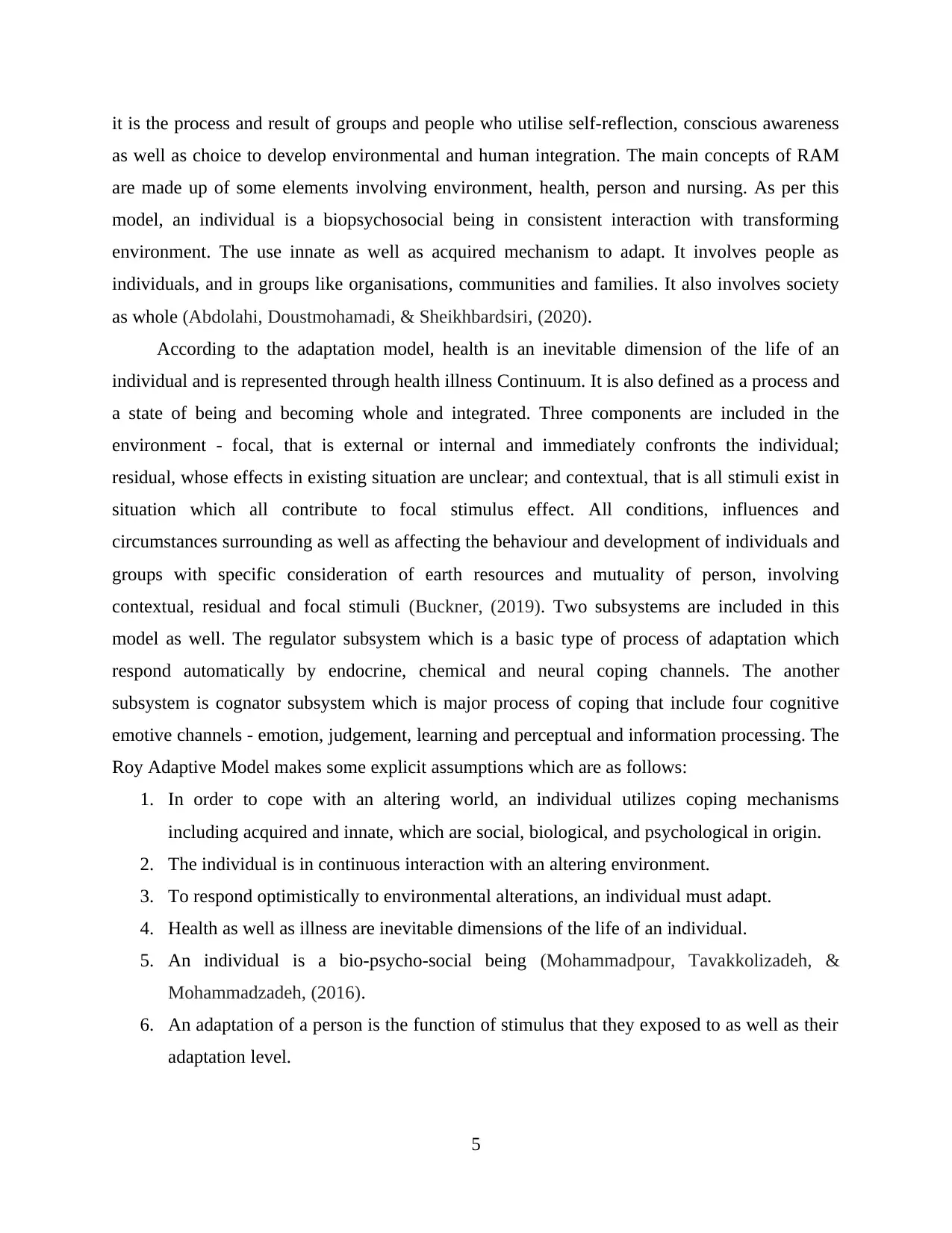
it is the process and result of groups and people who utilise self-reflection, conscious awareness
as well as choice to develop environmental and human integration. The main concepts of RAM
are made up of some elements involving environment, health, person and nursing. As per this
model, an individual is a biopsychosocial being in consistent interaction with transforming
environment. The use innate as well as acquired mechanism to adapt. It involves people as
individuals, and in groups like organisations, communities and families. It also involves society
as whole (Abdolahi, Doustmohamadi, & Sheikhbardsiri, (2020).
According to the adaptation model, health is an inevitable dimension of the life of an
individual and is represented through health illness Continuum. It is also defined as a process and
a state of being and becoming whole and integrated. Three components are included in the
environment - focal, that is external or internal and immediately confronts the individual;
residual, whose effects in existing situation are unclear; and contextual, that is all stimuli exist in
situation which all contribute to focal stimulus effect. All conditions, influences and
circumstances surrounding as well as affecting the behaviour and development of individuals and
groups with specific consideration of earth resources and mutuality of person, involving
contextual, residual and focal stimuli (Buckner, (2019). Two subsystems are included in this
model as well. The regulator subsystem which is a basic type of process of adaptation which
respond automatically by endocrine, chemical and neural coping channels. The another
subsystem is cognator subsystem which is major process of coping that include four cognitive
emotive channels - emotion, judgement, learning and perceptual and information processing. The
Roy Adaptive Model makes some explicit assumptions which are as follows:
1. In order to cope with an altering world, an individual utilizes coping mechanisms
including acquired and innate, which are social, biological, and psychological in origin.
2. The individual is in continuous interaction with an altering environment.
3. To respond optimistically to environmental alterations, an individual must adapt.
4. Health as well as illness are inevitable dimensions of the life of an individual.
5. An individual is a bio-psycho-social being (Mohammadpour, Tavakkolizadeh, &
Mohammadzadeh, (2016).
6. An adaptation of a person is the function of stimulus that they exposed to as well as their
adaptation level.
5
as well as choice to develop environmental and human integration. The main concepts of RAM
are made up of some elements involving environment, health, person and nursing. As per this
model, an individual is a biopsychosocial being in consistent interaction with transforming
environment. The use innate as well as acquired mechanism to adapt. It involves people as
individuals, and in groups like organisations, communities and families. It also involves society
as whole (Abdolahi, Doustmohamadi, & Sheikhbardsiri, (2020).
According to the adaptation model, health is an inevitable dimension of the life of an
individual and is represented through health illness Continuum. It is also defined as a process and
a state of being and becoming whole and integrated. Three components are included in the
environment - focal, that is external or internal and immediately confronts the individual;
residual, whose effects in existing situation are unclear; and contextual, that is all stimuli exist in
situation which all contribute to focal stimulus effect. All conditions, influences and
circumstances surrounding as well as affecting the behaviour and development of individuals and
groups with specific consideration of earth resources and mutuality of person, involving
contextual, residual and focal stimuli (Buckner, (2019). Two subsystems are included in this
model as well. The regulator subsystem which is a basic type of process of adaptation which
respond automatically by endocrine, chemical and neural coping channels. The another
subsystem is cognator subsystem which is major process of coping that include four cognitive
emotive channels - emotion, judgement, learning and perceptual and information processing. The
Roy Adaptive Model makes some explicit assumptions which are as follows:
1. In order to cope with an altering world, an individual utilizes coping mechanisms
including acquired and innate, which are social, biological, and psychological in origin.
2. The individual is in continuous interaction with an altering environment.
3. To respond optimistically to environmental alterations, an individual must adapt.
4. Health as well as illness are inevitable dimensions of the life of an individual.
5. An individual is a bio-psycho-social being (Mohammadpour, Tavakkolizadeh, &
Mohammadzadeh, (2016).
6. An adaptation of a person is the function of stimulus that they exposed to as well as their
adaptation level.
5
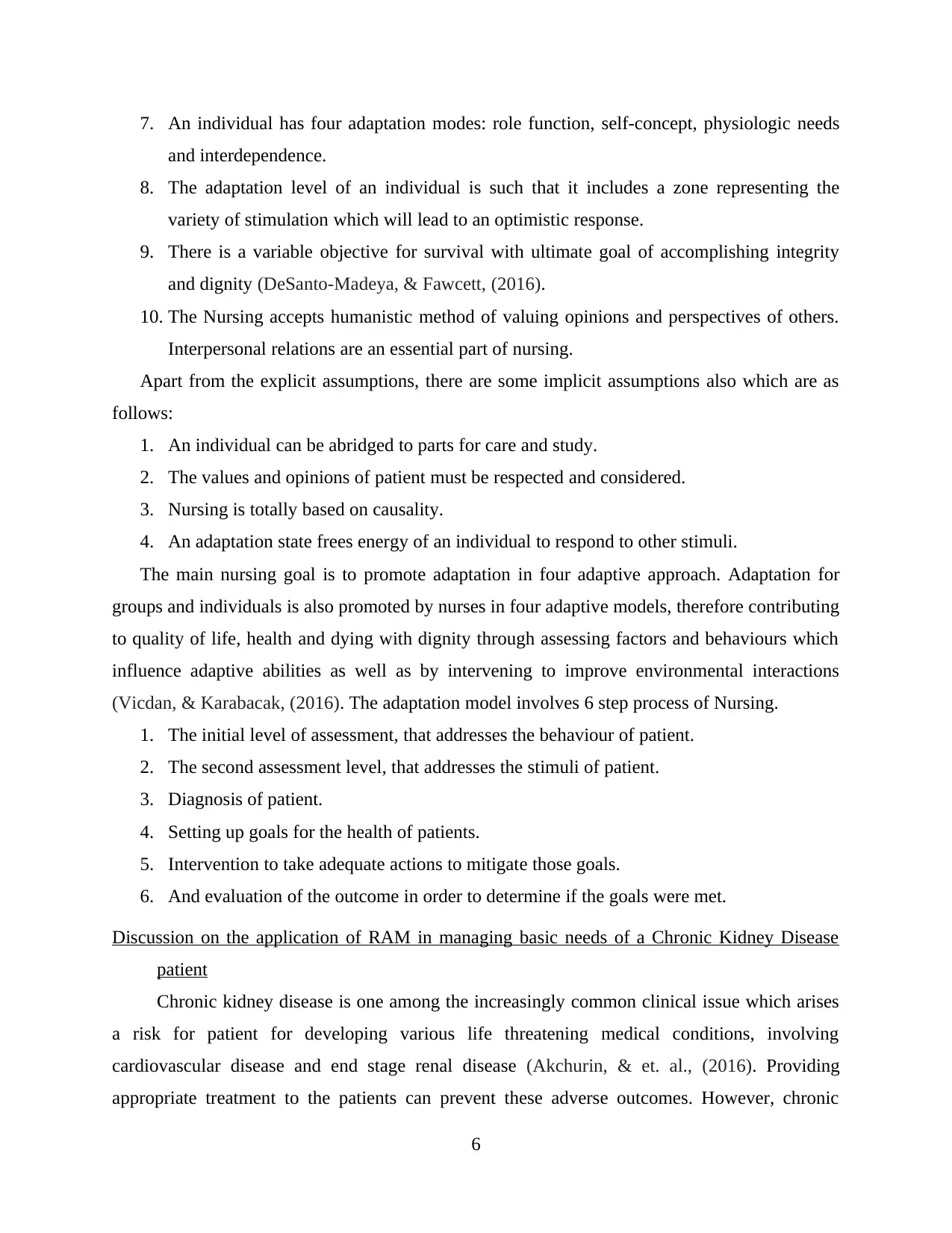
7. An individual has four adaptation modes: role function, self-concept, physiologic needs
and interdependence.
8. The adaptation level of an individual is such that it includes a zone representing the
variety of stimulation which will lead to an optimistic response.
9. There is a variable objective for survival with ultimate goal of accomplishing integrity
and dignity (DeSanto-Madeya, & Fawcett, (2016).
10. The Nursing accepts humanistic method of valuing opinions and perspectives of others.
Interpersonal relations are an essential part of nursing.
Apart from the explicit assumptions, there are some implicit assumptions also which are as
follows:
1. An individual can be abridged to parts for care and study.
2. The values and opinions of patient must be respected and considered.
3. Nursing is totally based on causality.
4. An adaptation state frees energy of an individual to respond to other stimuli.
The main nursing goal is to promote adaptation in four adaptive approach. Adaptation for
groups and individuals is also promoted by nurses in four adaptive models, therefore contributing
to quality of life, health and dying with dignity through assessing factors and behaviours which
influence adaptive abilities as well as by intervening to improve environmental interactions
(Vicdan, & Karabacak, (2016). The adaptation model involves 6 step process of Nursing.
1. The initial level of assessment, that addresses the behaviour of patient.
2. The second assessment level, that addresses the stimuli of patient.
3. Diagnosis of patient.
4. Setting up goals for the health of patients.
5. Intervention to take adequate actions to mitigate those goals.
6. And evaluation of the outcome in order to determine if the goals were met.
Discussion on the application of RAM in managing basic needs of a Chronic Kidney Disease
patient
Chronic kidney disease is one among the increasingly common clinical issue which arises
a risk for patient for developing various life threatening medical conditions, involving
cardiovascular disease and end stage renal disease (Akchurin, & et. al., (2016). Providing
appropriate treatment to the patients can prevent these adverse outcomes. However, chronic
6
and interdependence.
8. The adaptation level of an individual is such that it includes a zone representing the
variety of stimulation which will lead to an optimistic response.
9. There is a variable objective for survival with ultimate goal of accomplishing integrity
and dignity (DeSanto-Madeya, & Fawcett, (2016).
10. The Nursing accepts humanistic method of valuing opinions and perspectives of others.
Interpersonal relations are an essential part of nursing.
Apart from the explicit assumptions, there are some implicit assumptions also which are as
follows:
1. An individual can be abridged to parts for care and study.
2. The values and opinions of patient must be respected and considered.
3. Nursing is totally based on causality.
4. An adaptation state frees energy of an individual to respond to other stimuli.
The main nursing goal is to promote adaptation in four adaptive approach. Adaptation for
groups and individuals is also promoted by nurses in four adaptive models, therefore contributing
to quality of life, health and dying with dignity through assessing factors and behaviours which
influence adaptive abilities as well as by intervening to improve environmental interactions
(Vicdan, & Karabacak, (2016). The adaptation model involves 6 step process of Nursing.
1. The initial level of assessment, that addresses the behaviour of patient.
2. The second assessment level, that addresses the stimuli of patient.
3. Diagnosis of patient.
4. Setting up goals for the health of patients.
5. Intervention to take adequate actions to mitigate those goals.
6. And evaluation of the outcome in order to determine if the goals were met.
Discussion on the application of RAM in managing basic needs of a Chronic Kidney Disease
patient
Chronic kidney disease is one among the increasingly common clinical issue which arises
a risk for patient for developing various life threatening medical conditions, involving
cardiovascular disease and end stage renal disease (Akchurin, & et. al., (2016). Providing
appropriate treatment to the patients can prevent these adverse outcomes. However, chronic
6
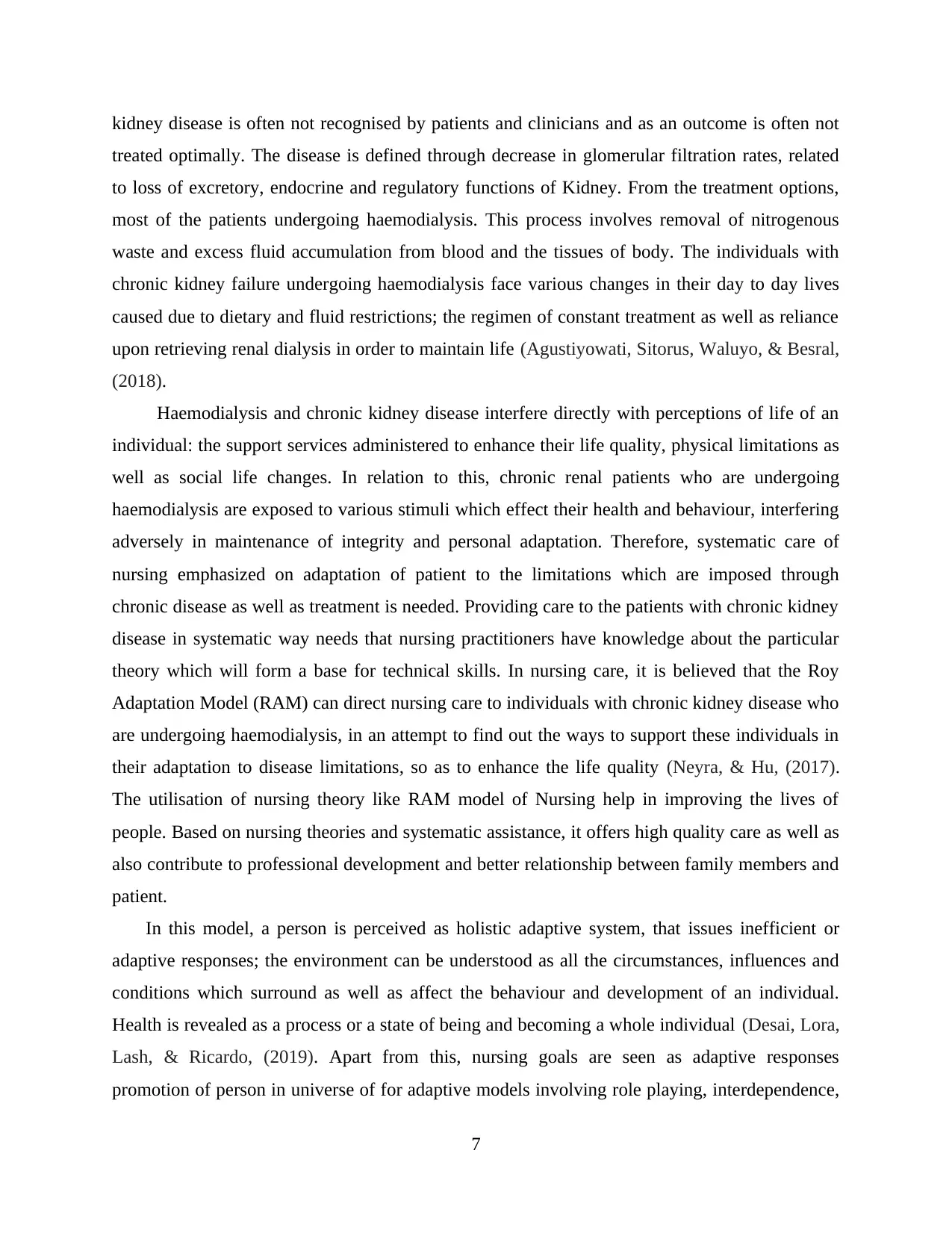
kidney disease is often not recognised by patients and clinicians and as an outcome is often not
treated optimally. The disease is defined through decrease in glomerular filtration rates, related
to loss of excretory, endocrine and regulatory functions of Kidney. From the treatment options,
most of the patients undergoing haemodialysis. This process involves removal of nitrogenous
waste and excess fluid accumulation from blood and the tissues of body. The individuals with
chronic kidney failure undergoing haemodialysis face various changes in their day to day lives
caused due to dietary and fluid restrictions; the regimen of constant treatment as well as reliance
upon retrieving renal dialysis in order to maintain life (Agustiyowati, Sitorus, Waluyo, & Besral,
(2018).
Haemodialysis and chronic kidney disease interfere directly with perceptions of life of an
individual: the support services administered to enhance their life quality, physical limitations as
well as social life changes. In relation to this, chronic renal patients who are undergoing
haemodialysis are exposed to various stimuli which effect their health and behaviour, interfering
adversely in maintenance of integrity and personal adaptation. Therefore, systematic care of
nursing emphasized on adaptation of patient to the limitations which are imposed through
chronic disease as well as treatment is needed. Providing care to the patients with chronic kidney
disease in systematic way needs that nursing practitioners have knowledge about the particular
theory which will form a base for technical skills. In nursing care, it is believed that the Roy
Adaptation Model (RAM) can direct nursing care to individuals with chronic kidney disease who
are undergoing haemodialysis, in an attempt to find out the ways to support these individuals in
their adaptation to disease limitations, so as to enhance the life quality (Neyra, & Hu, (2017).
The utilisation of nursing theory like RAM model of Nursing help in improving the lives of
people. Based on nursing theories and systematic assistance, it offers high quality care as well as
also contribute to professional development and better relationship between family members and
patient.
In this model, a person is perceived as holistic adaptive system, that issues inefficient or
adaptive responses; the environment can be understood as all the circumstances, influences and
conditions which surround as well as affect the behaviour and development of an individual.
Health is revealed as a process or a state of being and becoming a whole individual (Desai, Lora,
Lash, & Ricardo, (2019). Apart from this, nursing goals are seen as adaptive responses
promotion of person in universe of for adaptive models involving role playing, interdependence,
7
treated optimally. The disease is defined through decrease in glomerular filtration rates, related
to loss of excretory, endocrine and regulatory functions of Kidney. From the treatment options,
most of the patients undergoing haemodialysis. This process involves removal of nitrogenous
waste and excess fluid accumulation from blood and the tissues of body. The individuals with
chronic kidney failure undergoing haemodialysis face various changes in their day to day lives
caused due to dietary and fluid restrictions; the regimen of constant treatment as well as reliance
upon retrieving renal dialysis in order to maintain life (Agustiyowati, Sitorus, Waluyo, & Besral,
(2018).
Haemodialysis and chronic kidney disease interfere directly with perceptions of life of an
individual: the support services administered to enhance their life quality, physical limitations as
well as social life changes. In relation to this, chronic renal patients who are undergoing
haemodialysis are exposed to various stimuli which effect their health and behaviour, interfering
adversely in maintenance of integrity and personal adaptation. Therefore, systematic care of
nursing emphasized on adaptation of patient to the limitations which are imposed through
chronic disease as well as treatment is needed. Providing care to the patients with chronic kidney
disease in systematic way needs that nursing practitioners have knowledge about the particular
theory which will form a base for technical skills. In nursing care, it is believed that the Roy
Adaptation Model (RAM) can direct nursing care to individuals with chronic kidney disease who
are undergoing haemodialysis, in an attempt to find out the ways to support these individuals in
their adaptation to disease limitations, so as to enhance the life quality (Neyra, & Hu, (2017).
The utilisation of nursing theory like RAM model of Nursing help in improving the lives of
people. Based on nursing theories and systematic assistance, it offers high quality care as well as
also contribute to professional development and better relationship between family members and
patient.
In this model, a person is perceived as holistic adaptive system, that issues inefficient or
adaptive responses; the environment can be understood as all the circumstances, influences and
conditions which surround as well as affect the behaviour and development of an individual.
Health is revealed as a process or a state of being and becoming a whole individual (Desai, Lora,
Lash, & Ricardo, (2019). Apart from this, nursing goals are seen as adaptive responses
promotion of person in universe of for adaptive models involving role playing, interdependence,
7
Paraphrase This Document
Need a fresh take? Get an instant paraphrase of this document with our AI Paraphraser
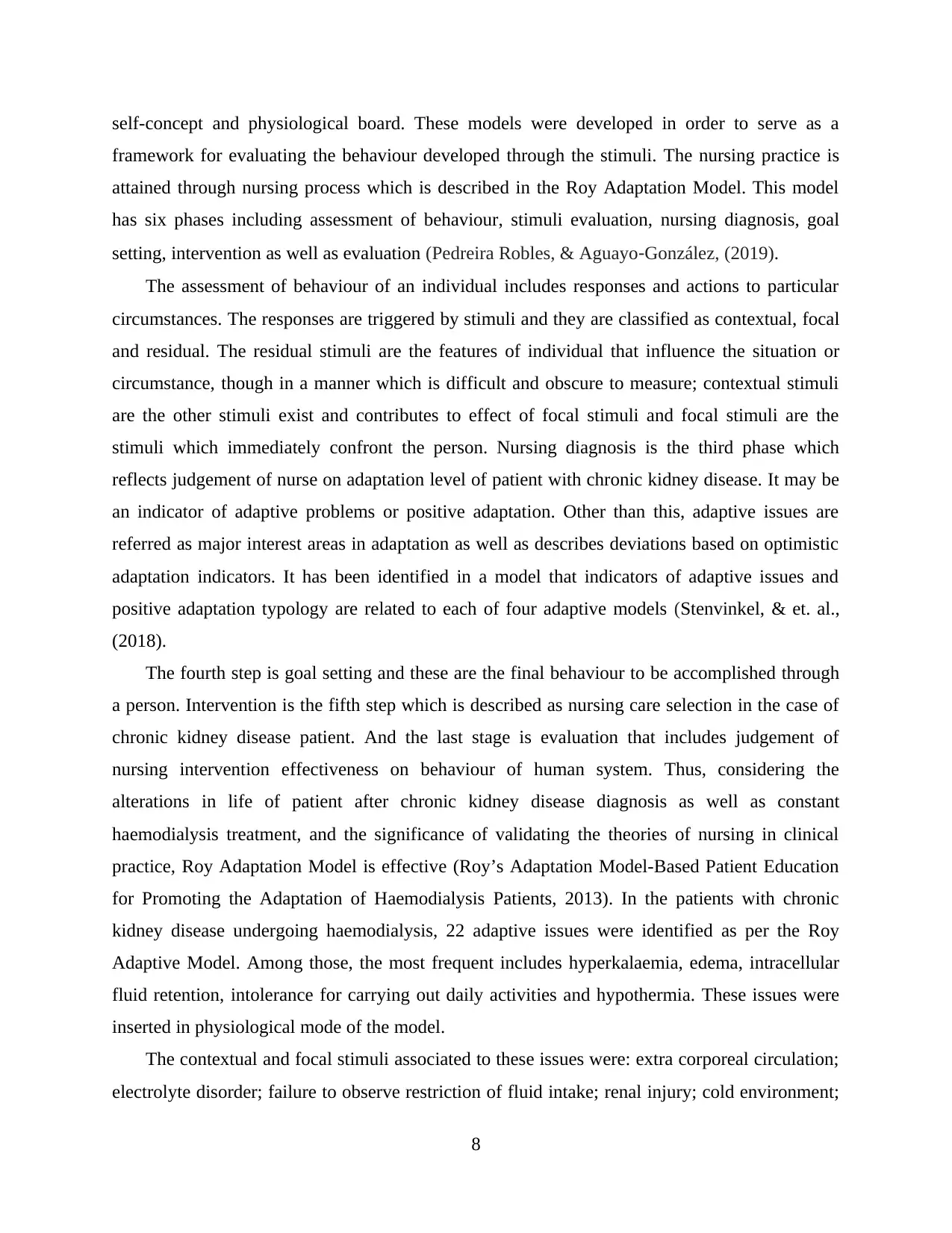
self-concept and physiological board. These models were developed in order to serve as a
framework for evaluating the behaviour developed through the stimuli. The nursing practice is
attained through nursing process which is described in the Roy Adaptation Model. This model
has six phases including assessment of behaviour, stimuli evaluation, nursing diagnosis, goal
setting, intervention as well as evaluation (Pedreira Robles, & Aguayo‐González, (2019).
The assessment of behaviour of an individual includes responses and actions to particular
circumstances. The responses are triggered by stimuli and they are classified as contextual, focal
and residual. The residual stimuli are the features of individual that influence the situation or
circumstance, though in a manner which is difficult and obscure to measure; contextual stimuli
are the other stimuli exist and contributes to effect of focal stimuli and focal stimuli are the
stimuli which immediately confront the person. Nursing diagnosis is the third phase which
reflects judgement of nurse on adaptation level of patient with chronic kidney disease. It may be
an indicator of adaptive problems or positive adaptation. Other than this, adaptive issues are
referred as major interest areas in adaptation as well as describes deviations based on optimistic
adaptation indicators. It has been identified in a model that indicators of adaptive issues and
positive adaptation typology are related to each of four adaptive models (Stenvinkel, & et. al.,
(2018).
The fourth step is goal setting and these are the final behaviour to be accomplished through
a person. Intervention is the fifth step which is described as nursing care selection in the case of
chronic kidney disease patient. And the last stage is evaluation that includes judgement of
nursing intervention effectiveness on behaviour of human system. Thus, considering the
alterations in life of patient after chronic kidney disease diagnosis as well as constant
haemodialysis treatment, and the significance of validating the theories of nursing in clinical
practice, Roy Adaptation Model is effective (Roy’s Adaptation Model-Based Patient Education
for Promoting the Adaptation of Haemodialysis Patients, 2013). In the patients with chronic
kidney disease undergoing haemodialysis, 22 adaptive issues were identified as per the Roy
Adaptive Model. Among those, the most frequent includes hyperkalaemia, edema, intracellular
fluid retention, intolerance for carrying out daily activities and hypothermia. These issues were
inserted in physiological mode of the model.
The contextual and focal stimuli associated to these issues were: extra corporeal circulation;
electrolyte disorder; failure to observe restriction of fluid intake; renal injury; cold environment;
8
framework for evaluating the behaviour developed through the stimuli. The nursing practice is
attained through nursing process which is described in the Roy Adaptation Model. This model
has six phases including assessment of behaviour, stimuli evaluation, nursing diagnosis, goal
setting, intervention as well as evaluation (Pedreira Robles, & Aguayo‐González, (2019).
The assessment of behaviour of an individual includes responses and actions to particular
circumstances. The responses are triggered by stimuli and they are classified as contextual, focal
and residual. The residual stimuli are the features of individual that influence the situation or
circumstance, though in a manner which is difficult and obscure to measure; contextual stimuli
are the other stimuli exist and contributes to effect of focal stimuli and focal stimuli are the
stimuli which immediately confront the person. Nursing diagnosis is the third phase which
reflects judgement of nurse on adaptation level of patient with chronic kidney disease. It may be
an indicator of adaptive problems or positive adaptation. Other than this, adaptive issues are
referred as major interest areas in adaptation as well as describes deviations based on optimistic
adaptation indicators. It has been identified in a model that indicators of adaptive issues and
positive adaptation typology are related to each of four adaptive models (Stenvinkel, & et. al.,
(2018).
The fourth step is goal setting and these are the final behaviour to be accomplished through
a person. Intervention is the fifth step which is described as nursing care selection in the case of
chronic kidney disease patient. And the last stage is evaluation that includes judgement of
nursing intervention effectiveness on behaviour of human system. Thus, considering the
alterations in life of patient after chronic kidney disease diagnosis as well as constant
haemodialysis treatment, and the significance of validating the theories of nursing in clinical
practice, Roy Adaptation Model is effective (Roy’s Adaptation Model-Based Patient Education
for Promoting the Adaptation of Haemodialysis Patients, 2013). In the patients with chronic
kidney disease undergoing haemodialysis, 22 adaptive issues were identified as per the Roy
Adaptive Model. Among those, the most frequent includes hyperkalaemia, edema, intracellular
fluid retention, intolerance for carrying out daily activities and hypothermia. These issues were
inserted in physiological mode of the model.
The contextual and focal stimuli associated to these issues were: extra corporeal circulation;
electrolyte disorder; failure to observe restriction of fluid intake; renal injury; cold environment;
8
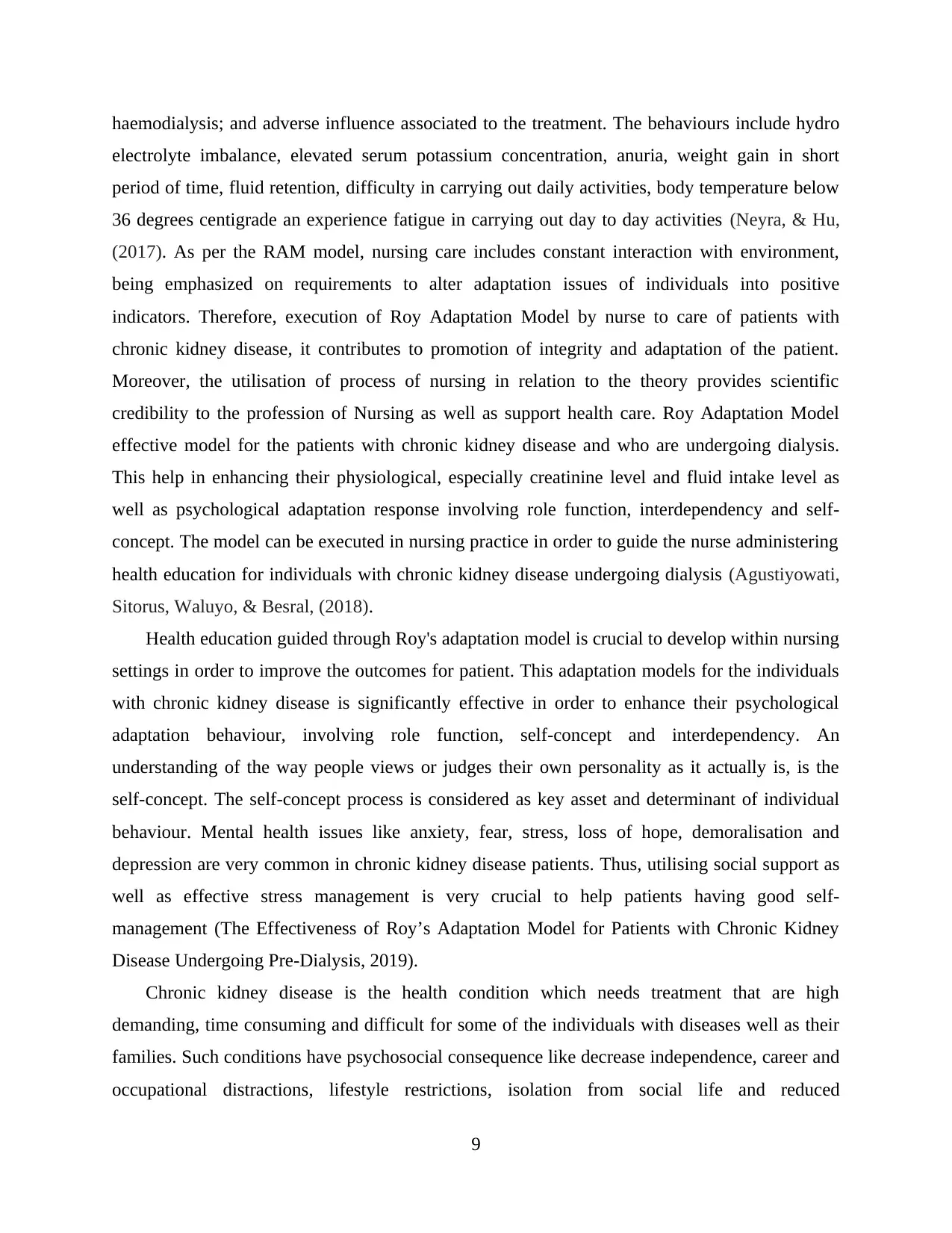
haemodialysis; and adverse influence associated to the treatment. The behaviours include hydro
electrolyte imbalance, elevated serum potassium concentration, anuria, weight gain in short
period of time, fluid retention, difficulty in carrying out daily activities, body temperature below
36 degrees centigrade an experience fatigue in carrying out day to day activities (Neyra, & Hu,
(2017). As per the RAM model, nursing care includes constant interaction with environment,
being emphasized on requirements to alter adaptation issues of individuals into positive
indicators. Therefore, execution of Roy Adaptation Model by nurse to care of patients with
chronic kidney disease, it contributes to promotion of integrity and adaptation of the patient.
Moreover, the utilisation of process of nursing in relation to the theory provides scientific
credibility to the profession of Nursing as well as support health care. Roy Adaptation Model
effective model for the patients with chronic kidney disease and who are undergoing dialysis.
This help in enhancing their physiological, especially creatinine level and fluid intake level as
well as psychological adaptation response involving role function, interdependency and self-
concept. The model can be executed in nursing practice in order to guide the nurse administering
health education for individuals with chronic kidney disease undergoing dialysis (Agustiyowati,
Sitorus, Waluyo, & Besral, (2018).
Health education guided through Roy's adaptation model is crucial to develop within nursing
settings in order to improve the outcomes for patient. This adaptation models for the individuals
with chronic kidney disease is significantly effective in order to enhance their psychological
adaptation behaviour, involving role function, self-concept and interdependency. An
understanding of the way people views or judges their own personality as it actually is, is the
self-concept. The self-concept process is considered as key asset and determinant of individual
behaviour. Mental health issues like anxiety, fear, stress, loss of hope, demoralisation and
depression are very common in chronic kidney disease patients. Thus, utilising social support as
well as effective stress management is very crucial to help patients having good self-
management (The Effectiveness of Roy’s Adaptation Model for Patients with Chronic Kidney
Disease Undergoing Pre-Dialysis, 2019).
Chronic kidney disease is the health condition which needs treatment that are high
demanding, time consuming and difficult for some of the individuals with diseases well as their
families. Such conditions have psychosocial consequence like decrease independence, career and
occupational distractions, lifestyle restrictions, isolation from social life and reduced
9
electrolyte imbalance, elevated serum potassium concentration, anuria, weight gain in short
period of time, fluid retention, difficulty in carrying out daily activities, body temperature below
36 degrees centigrade an experience fatigue in carrying out day to day activities (Neyra, & Hu,
(2017). As per the RAM model, nursing care includes constant interaction with environment,
being emphasized on requirements to alter adaptation issues of individuals into positive
indicators. Therefore, execution of Roy Adaptation Model by nurse to care of patients with
chronic kidney disease, it contributes to promotion of integrity and adaptation of the patient.
Moreover, the utilisation of process of nursing in relation to the theory provides scientific
credibility to the profession of Nursing as well as support health care. Roy Adaptation Model
effective model for the patients with chronic kidney disease and who are undergoing dialysis.
This help in enhancing their physiological, especially creatinine level and fluid intake level as
well as psychological adaptation response involving role function, interdependency and self-
concept. The model can be executed in nursing practice in order to guide the nurse administering
health education for individuals with chronic kidney disease undergoing dialysis (Agustiyowati,
Sitorus, Waluyo, & Besral, (2018).
Health education guided through Roy's adaptation model is crucial to develop within nursing
settings in order to improve the outcomes for patient. This adaptation models for the individuals
with chronic kidney disease is significantly effective in order to enhance their psychological
adaptation behaviour, involving role function, self-concept and interdependency. An
understanding of the way people views or judges their own personality as it actually is, is the
self-concept. The self-concept process is considered as key asset and determinant of individual
behaviour. Mental health issues like anxiety, fear, stress, loss of hope, demoralisation and
depression are very common in chronic kidney disease patients. Thus, utilising social support as
well as effective stress management is very crucial to help patients having good self-
management (The Effectiveness of Roy’s Adaptation Model for Patients with Chronic Kidney
Disease Undergoing Pre-Dialysis, 2019).
Chronic kidney disease is the health condition which needs treatment that are high
demanding, time consuming and difficult for some of the individuals with diseases well as their
families. Such conditions have psychosocial consequence like decrease independence, career and
occupational distractions, lifestyle restrictions, isolation from social life and reduced
9
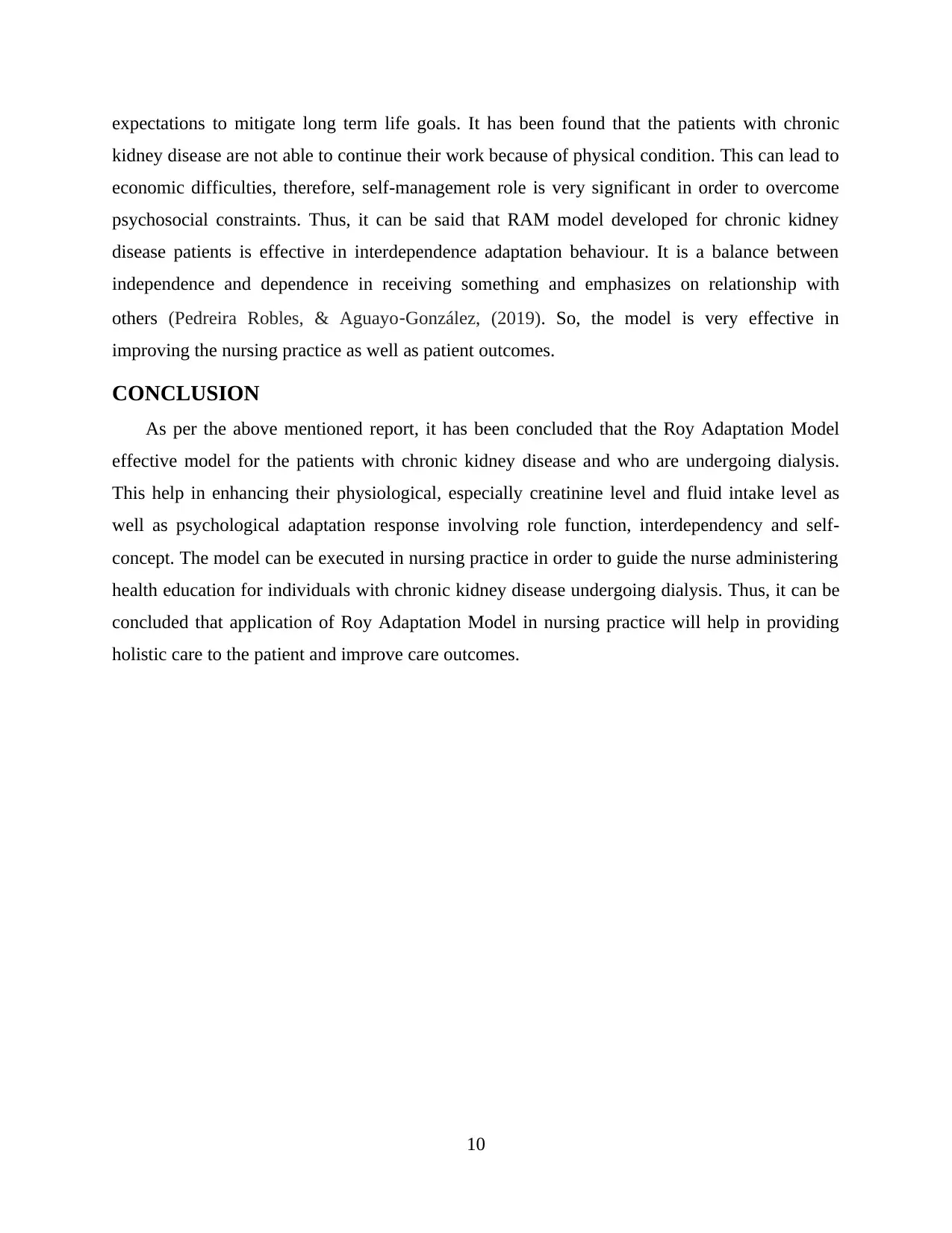
expectations to mitigate long term life goals. It has been found that the patients with chronic
kidney disease are not able to continue their work because of physical condition. This can lead to
economic difficulties, therefore, self-management role is very significant in order to overcome
psychosocial constraints. Thus, it can be said that RAM model developed for chronic kidney
disease patients is effective in interdependence adaptation behaviour. It is a balance between
independence and dependence in receiving something and emphasizes on relationship with
others (Pedreira Robles, & Aguayo‐González, (2019). So, the model is very effective in
improving the nursing practice as well as patient outcomes.
CONCLUSION
As per the above mentioned report, it has been concluded that the Roy Adaptation Model
effective model for the patients with chronic kidney disease and who are undergoing dialysis.
This help in enhancing their physiological, especially creatinine level and fluid intake level as
well as psychological adaptation response involving role function, interdependency and self-
concept. The model can be executed in nursing practice in order to guide the nurse administering
health education for individuals with chronic kidney disease undergoing dialysis. Thus, it can be
concluded that application of Roy Adaptation Model in nursing practice will help in providing
holistic care to the patient and improve care outcomes.
10
kidney disease are not able to continue their work because of physical condition. This can lead to
economic difficulties, therefore, self-management role is very significant in order to overcome
psychosocial constraints. Thus, it can be said that RAM model developed for chronic kidney
disease patients is effective in interdependence adaptation behaviour. It is a balance between
independence and dependence in receiving something and emphasizes on relationship with
others (Pedreira Robles, & Aguayo‐González, (2019). So, the model is very effective in
improving the nursing practice as well as patient outcomes.
CONCLUSION
As per the above mentioned report, it has been concluded that the Roy Adaptation Model
effective model for the patients with chronic kidney disease and who are undergoing dialysis.
This help in enhancing their physiological, especially creatinine level and fluid intake level as
well as psychological adaptation response involving role function, interdependency and self-
concept. The model can be executed in nursing practice in order to guide the nurse administering
health education for individuals with chronic kidney disease undergoing dialysis. Thus, it can be
concluded that application of Roy Adaptation Model in nursing practice will help in providing
holistic care to the patient and improve care outcomes.
10
Secure Best Marks with AI Grader
Need help grading? Try our AI Grader for instant feedback on your assignments.
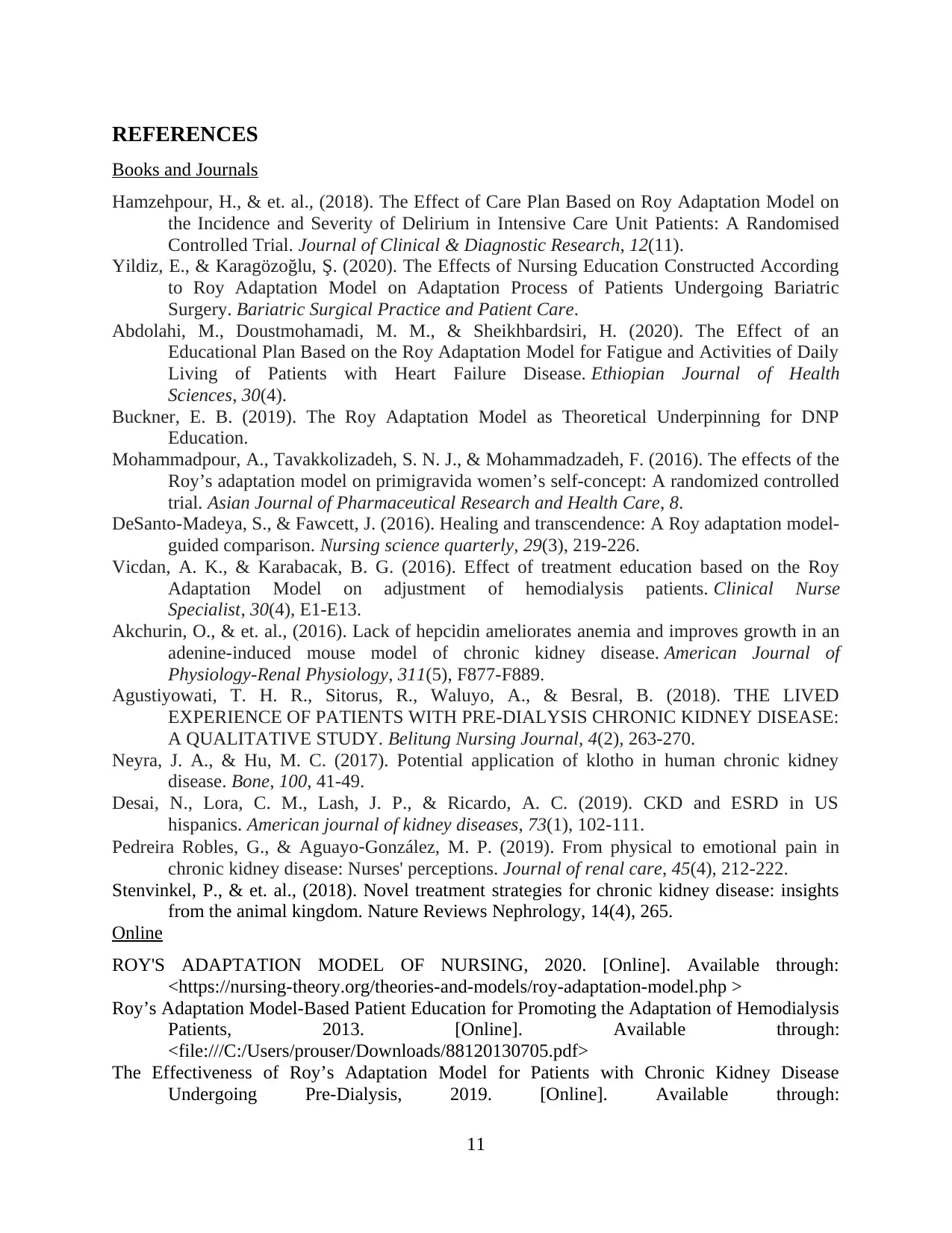
REFERENCES
Books and Journals
Hamzehpour, H., & et. al., (2018). The Effect of Care Plan Based on Roy Adaptation Model on
the Incidence and Severity of Delirium in Intensive Care Unit Patients: A Randomised
Controlled Trial. Journal of Clinical & Diagnostic Research, 12(11).
Yildiz, E., & Karagözoğlu, Ş. (2020). The Effects of Nursing Education Constructed According
to Roy Adaptation Model on Adaptation Process of Patients Undergoing Bariatric
Surgery. Bariatric Surgical Practice and Patient Care.
Abdolahi, M., Doustmohamadi, M. M., & Sheikhbardsiri, H. (2020). The Effect of an
Educational Plan Based on the Roy Adaptation Model for Fatigue and Activities of Daily
Living of Patients with Heart Failure Disease. Ethiopian Journal of Health
Sciences, 30(4).
Buckner, E. B. (2019). The Roy Adaptation Model as Theoretical Underpinning for DNP
Education.
Mohammadpour, A., Tavakkolizadeh, S. N. J., & Mohammadzadeh, F. (2016). The effects of the
Roy’s adaptation model on primigravida women’s self-concept: A randomized controlled
trial. Asian Journal of Pharmaceutical Research and Health Care, 8.
DeSanto-Madeya, S., & Fawcett, J. (2016). Healing and transcendence: A Roy adaptation model-
guided comparison. Nursing science quarterly, 29(3), 219-226.
Vicdan, A. K., & Karabacak, B. G. (2016). Effect of treatment education based on the Roy
Adaptation Model on adjustment of hemodialysis patients. Clinical Nurse
Specialist, 30(4), E1-E13.
Akchurin, O., & et. al., (2016). Lack of hepcidin ameliorates anemia and improves growth in an
adenine-induced mouse model of chronic kidney disease. American Journal of
Physiology-Renal Physiology, 311(5), F877-F889.
Agustiyowati, T. H. R., Sitorus, R., Waluyo, A., & Besral, B. (2018). THE LIVED
EXPERIENCE OF PATIENTS WITH PRE-DIALYSIS CHRONIC KIDNEY DISEASE:
A QUALITATIVE STUDY. Belitung Nursing Journal, 4(2), 263-270.
Neyra, J. A., & Hu, M. C. (2017). Potential application of klotho in human chronic kidney
disease. Bone, 100, 41-49.
Desai, N., Lora, C. M., Lash, J. P., & Ricardo, A. C. (2019). CKD and ESRD in US
hispanics. American journal of kidney diseases, 73(1), 102-111.
Pedreira Robles, G., & Aguayo‐González, M. P. (2019). From physical to emotional pain in
chronic kidney disease: Nurses' perceptions. Journal of renal care, 45(4), 212-222.
Stenvinkel, P., & et. al., (2018). Novel treatment strategies for chronic kidney disease: insights
from the animal kingdom. Nature Reviews Nephrology, 14(4), 265.
Online
ROY'S ADAPTATION MODEL OF NURSING, 2020. [Online]. Available through:
<https://nursing-theory.org/theories-and-models/roy-adaptation-model.php >
Roy’s Adaptation Model-Based Patient Education for Promoting the Adaptation of Hemodialysis
Patients, 2013. [Online]. Available through:
<file:///C:/Users/prouser/Downloads/88120130705.pdf>
The Effectiveness of Roy’s Adaptation Model for Patients with Chronic Kidney Disease
Undergoing Pre-Dialysis, 2019. [Online]. Available through:
11
Books and Journals
Hamzehpour, H., & et. al., (2018). The Effect of Care Plan Based on Roy Adaptation Model on
the Incidence and Severity of Delirium in Intensive Care Unit Patients: A Randomised
Controlled Trial. Journal of Clinical & Diagnostic Research, 12(11).
Yildiz, E., & Karagözoğlu, Ş. (2020). The Effects of Nursing Education Constructed According
to Roy Adaptation Model on Adaptation Process of Patients Undergoing Bariatric
Surgery. Bariatric Surgical Practice and Patient Care.
Abdolahi, M., Doustmohamadi, M. M., & Sheikhbardsiri, H. (2020). The Effect of an
Educational Plan Based on the Roy Adaptation Model for Fatigue and Activities of Daily
Living of Patients with Heart Failure Disease. Ethiopian Journal of Health
Sciences, 30(4).
Buckner, E. B. (2019). The Roy Adaptation Model as Theoretical Underpinning for DNP
Education.
Mohammadpour, A., Tavakkolizadeh, S. N. J., & Mohammadzadeh, F. (2016). The effects of the
Roy’s adaptation model on primigravida women’s self-concept: A randomized controlled
trial. Asian Journal of Pharmaceutical Research and Health Care, 8.
DeSanto-Madeya, S., & Fawcett, J. (2016). Healing and transcendence: A Roy adaptation model-
guided comparison. Nursing science quarterly, 29(3), 219-226.
Vicdan, A. K., & Karabacak, B. G. (2016). Effect of treatment education based on the Roy
Adaptation Model on adjustment of hemodialysis patients. Clinical Nurse
Specialist, 30(4), E1-E13.
Akchurin, O., & et. al., (2016). Lack of hepcidin ameliorates anemia and improves growth in an
adenine-induced mouse model of chronic kidney disease. American Journal of
Physiology-Renal Physiology, 311(5), F877-F889.
Agustiyowati, T. H. R., Sitorus, R., Waluyo, A., & Besral, B. (2018). THE LIVED
EXPERIENCE OF PATIENTS WITH PRE-DIALYSIS CHRONIC KIDNEY DISEASE:
A QUALITATIVE STUDY. Belitung Nursing Journal, 4(2), 263-270.
Neyra, J. A., & Hu, M. C. (2017). Potential application of klotho in human chronic kidney
disease. Bone, 100, 41-49.
Desai, N., Lora, C. M., Lash, J. P., & Ricardo, A. C. (2019). CKD and ESRD in US
hispanics. American journal of kidney diseases, 73(1), 102-111.
Pedreira Robles, G., & Aguayo‐González, M. P. (2019). From physical to emotional pain in
chronic kidney disease: Nurses' perceptions. Journal of renal care, 45(4), 212-222.
Stenvinkel, P., & et. al., (2018). Novel treatment strategies for chronic kidney disease: insights
from the animal kingdom. Nature Reviews Nephrology, 14(4), 265.
Online
ROY'S ADAPTATION MODEL OF NURSING, 2020. [Online]. Available through:
<https://nursing-theory.org/theories-and-models/roy-adaptation-model.php >
Roy’s Adaptation Model-Based Patient Education for Promoting the Adaptation of Hemodialysis
Patients, 2013. [Online]. Available through:
<file:///C:/Users/prouser/Downloads/88120130705.pdf>
The Effectiveness of Roy’s Adaptation Model for Patients with Chronic Kidney Disease
Undergoing Pre-Dialysis, 2019. [Online]. Available through:
11
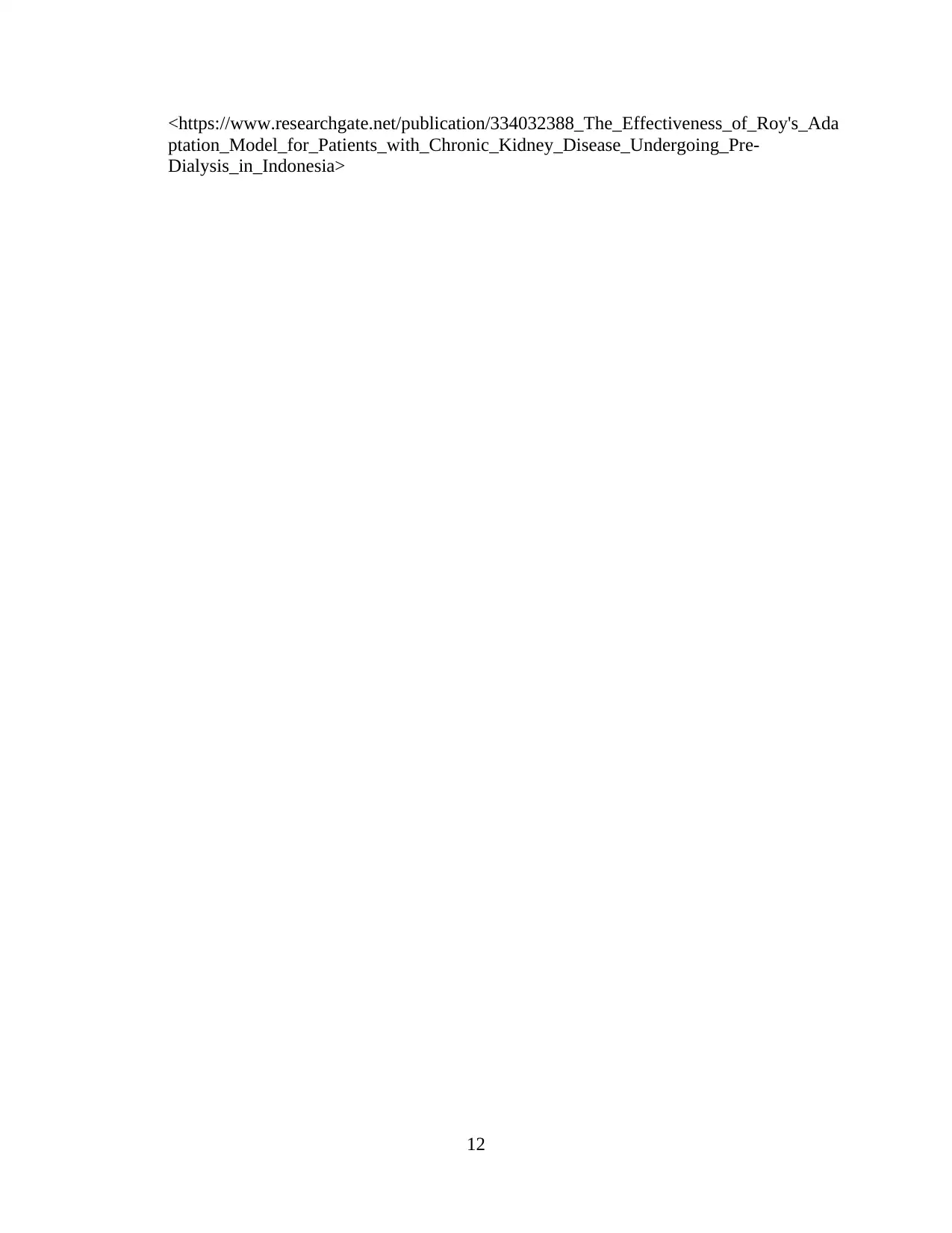
<https://www.researchgate.net/publication/334032388_The_Effectiveness_of_Roy's_Ada
ptation_Model_for_Patients_with_Chronic_Kidney_Disease_Undergoing_Pre-
Dialysis_in_Indonesia>
12
ptation_Model_for_Patients_with_Chronic_Kidney_Disease_Undergoing_Pre-
Dialysis_in_Indonesia>
12
1 out of 12
Related Documents
Your All-in-One AI-Powered Toolkit for Academic Success.
+13062052269
info@desklib.com
Available 24*7 on WhatsApp / Email
![[object Object]](/_next/static/media/star-bottom.7253800d.svg)
Unlock your academic potential
© 2024 | Zucol Services PVT LTD | All rights reserved.





